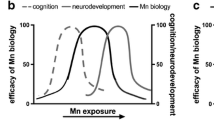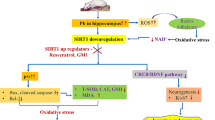Abstract
Increasing industrial and military use of uranium has led to environmental pollution, which may result in uranium reaching the brain and causing cerebral dysfunction. A recent literature review has discussed data published over the last 10 years on uranium and its effects on brain function (Dinocourt C, Legrand M, Dublineau I, et al., Toxicology 337:58–71, 2015). New models of uranium exposure during neonatal brain development and the emergence of new technologies (omics and epigenetics) are of value in identifying new specific targets of uranium. Here we review the latest studies of neurogenesis, epigenetics, and metabolic dysfunctions and the identification of new biomarkers used to establish potential pathophysiological states of neurodevelopmental and neurodegenerative diseases.
Access this chapter
Tax calculation will be finalised at checkout
Purchases are for personal use only
Similar content being viewed by others
References
Abou-Donia MB, Dechkovskaia AM, Goldstein LB, et al. Uranyl acetate-induced sensorimotor deficit and increased nitric oxide generation in the central nervous system in rats. Pharmacol Biochem Behav. 2002;72:881–90.
Agency for Toxic Substances and Disease Registry (ATSDR). Toxicological profile for Uranium. Atlanta: U.S. Department of Health and Human Services, Public Health Service; 2013.
Albina ML, Bellés M, Linares V, et al. Restraint stress does not enhance the uranium-induced developmental and behavioral effects in the offspring of uranium-exposed male rats. Toxicology. 2005;215:69–79.
Altman J, Bayer SA. Migration and distribution of two populations of hippocampal granule cell precursors during the perinatal and postnatal periods. J Comp Neurol. 1990;301(3):365–81.
Barillet S, Adam C, Palluel O, et al. Bioaccumulation, oxidative stress, and neurotoxicity in Danio rerio exposed to different isotopic compositions of uranium. Environ Toxicol Chem. 2007;26:497–505.
Barillet S, Adam-Guillermin C, Palluel O, et al. Uranium bioaccumulation and biological disorders induced in zebrafish (Danio rerio) after a depleted uranium waterborne exposure. Environ Pollut. 2011;159:495–502.
Bayer SA. Development of the hippocampal region in the rat. II. Morphogenesis during embryonic and early postnatal life. J Comp Neurol. 1980;190(1):115–34.
Bensoussan H, Grancolas L, Dhieux-Lestaevel B, et al. Heavy metal uranium affects the brain cholinergic system in rat following sub-chronic and chronic exposure. Toxicology. 2009;261:59–67.
Bleise A, Danesi PR, Burkart W. Properties, use and health effects of depleted uranium (DU): a general overview. J Environ Radioact. 2003;64:93–112.
Briner W, Abboud B. Behavior of juvenile mice chronically exposed to depleted uranium. In: Khassanova L, Collery P, Maymard I, Khassanova Z, Etienne JC, editors. Metal ions in biology and medicine. Paris: John Libby Eurotext; 2002. p. 353–6.
Briner W, Davis D. Lipid oxidation and behavior are correlated in depleted uranium exposed mice. In: Khassanova L, Collery P, Maymard I, Khassanova Z, Etienne JC, editors. Metal ions in biology and medicine. Paris: John Libby Eurotext; 2002. p. 59–63.
Briner W, Murray J. Effects of short-term and long-term depleted uranium exposure on open-field behavior and brain lipid oxidation in rats. Neurotoxicol Teratol. 2005;27:135–44.
Bussy C, Lestaevel P, Dhieux B, et al. Chronic ingestion of uranyl nitrate perturbs acetylcholinesterase activity and monoamine metabolism in male rat brain. Neurotoxicology. 2006;27:245–52.
Ceccatelli S, Bose R, Edoff K, et al. Long-lasting neurotoxic effects of exposure to methylmercury during development. J Intern Med. 2013;273(5):490–7.
Cheng TF, Choudhuri S, Muldoon-Jacobs K. Epigenetic targets of some toxicologically relevant metals: a review of the literature. J Appl Toxicol. 2012;32:643–53.
Dinocourt C, Stefani J et al. Reduced carbachol-induced beta/gamma oscillations in CA3 region of hippocampus after post-natal contamination of uranium in adult rat. Meeting abstract, Neurosciences, Washington, DC. 2014. November 2014.
Dinocourt C, Legrand M, Dublineau I, et al. The neurotoxicology of uranium. Toxicology. 2015;337:58–71.
Dinocourt C, et al. Chronic exposure to uranium from gestation: Effects on behavior and neurogenesis in adulthood. Int J Environ Res Public Health. 2017;14(5):536.
Domingo JL. Reproductive and developmental toxicity of natural and depleted uranium: a review. Reprod Toxicol. 2001;15:603–9.
Dublineau I, Souidi M, Gueguen Y, et al. Unexpected lack of deleterious effects of uranium on physiological systems following a chronic oral intake in adult rat. Biomed Res Int. 2014; doi:10.1155/2014/181989.
Elmhiri G, Gloaguen C, Kereselidze D, et al. Multigenerational effects of chronic low-dose natural uranium contamination: epigenetic inheritance of methylation signature. Toxicol Lett. 2016;259S:S73–S247. http://dx.doi.org/10.1016/j.toxlet.2016.07.293
Franco R, Schoneveld O, Georgakilas AG, et al. Oxidative stress, DNA methylation and carcinogenesis. Cancer Lett. 2008;266(1):6–11.
Gapp K, Jawaid A, Sarkies P, et al. Implication of sperm RNAs in transgenerational inheritance of the effects of early trauma in mice. Nat Neurosci. 2014;17(5):667–9.
Ghosh S, Kumar A, Pandey BN, et al. Acute exposure of uranyl nitrate causes lipid peroxidation and histopathological damage in brain and bone of Wistar rat. J Environ Pathol Toxicol Oncol. 2007;26:255–61.
Gombeau K, Pereira S, Ravanat JL, et al. Depleted uranium induces sex- and tissue-specific methylation patterns in adult zebrafish. J Environ Radioact. 2016;154:25–33.
Gonzalez-Riano C, Garcia A, Barbas C. Metabolomics studies in brain tissue: a review. J Pharm Biomed Anal. 2016;130:141–68.
Gotz M, Huttner WB. The cell biology of neurogenesis. Nature reviews. Mol Cell Biol. 2005;6(10):777–88.
Grandjean P, Landrigan PJ. Neurobehavioural effects of developmental toxicity. Lancet Neurol. 2014;13:330–8.
Grison S, Favé G, Maillot M, et al. Metabolomics identifies a biological response to chronic low-dose natural uranium contamination in urine samples. Metabolomics. 2013;9(6):1168–80.
Grison S, Favé G, Maillot M, et al. Metabolomics reveals dose effects of low-dose chronic exposure to uranium in rats: identification of candidate biomarkers in urine samples. Metabolomics. 2016;12(10):154.
Hirst M, Marra MA. Next generation sequencing based approaches to epigenomics. Brief Funct Genomics. 2010;9(5–6):455–65.
Hon GC, Hawkins RD, Caballero OL, et al. Global DNA hypomethylation coupled to repressive chromatin domain formation and gene silencing in breast cancer. Genome Res. 2012;22(2):246–58.
Houpert P, Frelon S, Lestaevel P, et al. Parental exposure to enriched uranium induced delayed hyperactivity in rat offspring. Neurotoxicology. 2007;28:108–13.
Huang D, Zhang Y, Qi Y, et al. Global DNA hypomethylation, rather than reactive oxygen species (ROS), a potential facilitator of cadmium-stimulated K562 cell proliferation. Toxicol Lett. 2008;179(1):43–7.
Jiang G, Aschner M. Neurotoxicity of depleted uranium: reasons for increased concern. Biol Trace Elem Res. 2006;110:1–17.
Kaddurah-Daouk R, Krishnan KR. Metabolomics: a global biochemical approach to the study of central nervous system diseases. Neuropsychopharmacology. 2009;34:173–86.
Legrand M, Elie C, Stefani J, et al. Cell proliferation and cell death are disturbed during prenatal and postnatal brain development after uranium exposure. Neurotoxicology. 2016a;52:34–45.
Legrand M, Lam S, Anselme I et al. Exposure to depleted uranium during development affects neuronal differentiation in the hippocampal dentate gyrus and induces depressive-like behavior in offspring. Neurotoxicology. 2016b. http://dx.doi.org/10.1016/j.neuro.2016.09.006
Lerebours A, Gonzalez P, Adam C, et al. Comparative analysis of gene expression in brain, liver, skeletal muscles, and gills of zebrafish (Danio rerio) exposed to environmentally relevant waterborne uranium concentrations. Environ Toxicol Chem. 2009;28:1271–8.
Lerebours A, Adam-Guillermin C, Brèthes D, et al. Mitochondrial energetic metabolism perturbations in skeletal muscles and brain of zebrafish (Danio rerio) exposed to low concentrations of waterborne uranium. Aquat Toxicol. 2010;100(1):66–74.
Lestaevel P, Romero E, Dhieux B, et al. Different pattern of brain pro-/anti-oxidant activity between depleted and enriched uranium in chronically exposed rats. Toxicology. 2009;258:1–9.
Lestaevel P, Bensoussan H, Dhieux B, et al. Cerebral cortex and hippocampus respond differently after post-natal exposure to uranium. J Toxicol Sci. 2013;38:803–11.
Lestaevel P, Dhieux B, Delissen O, et al. Uranium modifies or not behavior and antioxidant status in the hippocampus of rats exposed since birth. J Toxicol Sci. 2015;40:99–107.
Lestaevel P, Grison S, Favé G, et al. Assessment of the central effects of natural uranium via behavioural performances and the cerebrospinal fluid metabolome. Neural Plast. 2016; doi:10.1155/2016/9740353.
Linares V, Sanchez DJ, Belles M, et al. Pro-oxidant effects in the brain of rats concurrently exposed to uranium and stress. Toxicology. 2007;236:82–91.
Linney E, Upchurch L, Donerly S. Zebrafish as a neurotoxicological model. Neurotoxicol Teratol. 2004;26(6):709–18.
Maruyama W, Abe T, Tohgi H, et al. A dopaminergic neurotoxin, (R)-N-methylsalsolinol, increases in parkinsonian cerebrospinal fluid. Ann Neurol. 1996;40:119–22.
Miller AC, Stewart M, Rivas R. DNA methylation during depleted uranium-induced leukemia. Biochimie. 2009;91:1328–30.
Mouradian MM. MicroRNAs in Parkinson’s disease. Neurobiol Dis. 2012;46:279–84.
Naoi M, Maruyama W, Dostert P, et al. N-methyl-(R)-salsolinol as a dopaminergic neurotoxin: from an animal model to an early marker of Parkinson’s disease. J Neural Transm. 1997;50(Suppl):89–105.
Paquet F, Houpert P, Blanchardon E, et al. Accumulation and distribution of uranium in rats after chronic exposure by ingestion. Health Phys. 2006;90:139–47.
Paternain JL, Domingo JL, Ortega A, et al. The effects of uranium on reproduction, gestation, and postnatal survival in mice. Ecotoxicol Environ Saf. 1989;17:291–6.
Pellmar TC, Keyser DO, Emery C, et al. Electrophysiological changes in hippocampal slices isolated from rats embedded with depleted uranium fragments. Neurotoxicology. 1999;20:785–92.
Petitot F, Frelon S, Chambon C, et al. Proteome changes in rat serum after a chronic ingestion of enriched uranium: toward a biological signature of internal contamination and radiological effect. Toxicol Lett. 2016;257:44–59.
Rudenko A, Tsai LH. Epigenetic regulation in memory and cognitive disorders. Neuroscience. 2014;264:51–63.
Su S, Jin Y, Zhang W, et al. Aberrant promoter methylation of p16(INK4a) and O(6)-methylguanine-DNA methyltransferase genes in workers at a Chinese uranium mine. J Occup Health. 2006;48(4):261–6.
Takiguchi M, Achanzar WE, Qu W, et al. Effects of cadmium on DNA-(Cytosine-5) methyltransferase activity and DNA methylation status during cadmium-induced cellular transformation. Exp Cell Res. 2003;286(2):355–65.
Tomsig JL, Suszkiw JB. Metal selectivity of exocytosis in alpha-toxin-permeabilized bovine chromaffin cells. J Neurochem. 1996;66:644–50.
Valinluck V, Tsai HH, Rogstad DK, et al. Oxidative damage to methyl-CpG sequences inhibits the binding of the methyl-CpG binding domain (MBD) of methyl-CpG binding protein 2 (MeCP2). Nucleic Acids Res. 2004;32(14):4100–8.
Acknowledgments
We thank Christelle Adam-Guillermin and Maamar Souidi for their critical reading, specifically on epigenetic and metabolic pathways, of the manuscript.
Author information
Authors and Affiliations
Corresponding author
Editor information
Editors and Affiliations
Rights and permissions
Copyright information
© 2017 Springer International Publishing AG
About this chapter
Cite this chapter
Dinocourt, C. (2017). Uranium and the Central Nervous System: What Should We Learn from Recent New Tools and Findings?. In: Aschner, M., Costa, L. (eds) Neurotoxicity of Metals. Advances in Neurobiology, vol 18. Springer, Cham. https://doi.org/10.1007/978-3-319-60189-2_11
Download citation
DOI: https://doi.org/10.1007/978-3-319-60189-2_11
Published:
Publisher Name: Springer, Cham
Print ISBN: 978-3-319-60188-5
Online ISBN: 978-3-319-60189-2
eBook Packages: Biomedical and Life SciencesBiomedical and Life Sciences (R0)




